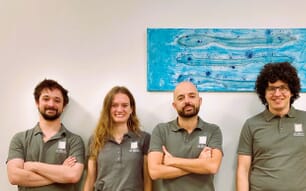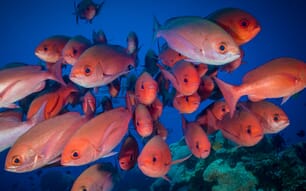The Sargasso Sea is a large oceanic area between Bermuda and the West Indies. There are 19 species of eel in the world. Two of them spawn in the Sargasso Sea: The American and The European Eel.
In the past 30 years there has been a dramatic decline in the European eel population. Today, the number of young eel returning to the coasts of Europe is just two to 10 per cent of the quantities seen in the 1970s. In 2008, the dramatic decline in eel numbers led the International Union for Conservation of Nature (IUCN) to add the eel to its list of critically endangered species.
A characteristic feature of the European eel is that spawning takes place far from the juvenile nursery grounds in Europe, requiring the eel larvae to ride the ocean currents for a 6,000 kilometre return journey across the Atlantic. The expedition will investigate whether climate-related changes in the eel’s spawning grounds or the ocean currents transporting the eel larvae to Europe are responsible for the eel’s sharp decline. The expedition will also gather information on the food preferences of the newly hatched eel – the understanding of eel larval feeding is a prerequisite for successful rearing of larvae and the farming of eel. Farmed eel can be used for re-stocking and using these for consumption would lower the fishing pressure on the population.
The expedition brings together almost 40 experts from a wide range of research areas at both Danish and international universities and institutions (including French, German,Swedish and American participants). The expedition, which is headed by Senior Researcher Peter Munk from DTU Aqua, is funded by the Danish Centre for Marine Research and the Carlsberg Foundation. The marine research vessel, Dana, is owned by DTU.
Proud tradition
The Sargasso Sea Eel Expedition 2014 is taking place 101 years after the first expedition targeting the eel’s spawning grounds. The 1913 expedition was organized by the Danish researcher and biologist Dr Johannes Schmidt, who several years earlier had suggested that the eel spawning grounds would be in the mid-Atlantic. Subsequent expeditions to the eel spawning grounds have basically confirmed Schmidt’s findings, but there are still many unanswered questions concerning the reproduction and early life of the European eel.
Eel farming
Despite attempts spanning several decades to establish large-scale eel breeding in captivity, eel farming has been unsuccessful. DTU Aqua in Denmark have managed to produce viable eggs, hatch larvae and sustain their life for up to 26 days, which is a world record for European eel and an important step towards successful breeding. The next major challenge is to find a suitable larval food source. The study of eel larvae and their potential food sources on the eel expedition, will contribute to the general understanding of larval feeding and could give an important input to these breeding attempts..
The 2014-expedition will search for the specific areas of eel spawning and investigate how the spawning could be affected by climate-dependent fronts and ocean currents. Further they will look into the questions: why the eel spawns in the Sargasso Sea, which route the eel larvae take back to Europe, and what they feed on during their long migration. The eel spawn in an area where warm subtropical and colder northern waters meet, and the researchers will examine whether climate change leading to higher temperatures of subtropical waters, could affect eel larvae survival and thus the numbers of larvae returning to Europe.
The expedition research project will examine:
- The extent of the spawning area – do the spawning eel congregate in specific areas?
- How water masses and ocean currents affect eel egg and larval transport
- Whether presence of eel can be determined on the basis of DNA remains present in the water
- Whether larval transport is directed to areas of particularly good feeding conditions
- What are the food items of eel during the early stages?
- Larval swimming behaviour
- Larval growth and the growth of their potential food source
- The production of potential food sources – how many are consumed and how many sink to the bottom of the ocean?
- The condition of the eels spawning in the Sargasso Sea (assuming it is possible to catch an adult eel)
- Whether larval survival is linked to climate change and whether there has been a climate change influencing the spawning area conditions during the past 20 years.




